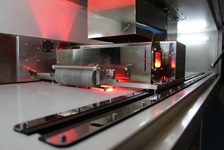Crossref Citations
This article has been cited by the following publications. This list is generated based on data provided by
Crossref.
Lu, Tianxin
Collings, Neil
Robertson, Brian
and
Chu, Daping
2015.
Design of a low-cost and compact 1 × 5 wavelength-selective switch for access networks.
Applied Optics,
Vol. 54,
Issue. 30,
p.
8844.
Ellis, Adam
Hartley, Liam
and
Hopkinson, Neil
2015.
Effect of Print Density on the Properties of High Speed Sintered Elastomers.
Metallurgical and Materials Transactions A,
Vol. 46,
Issue. 9,
p.
3883.
Ellis, Adam
Brown, Ryan
and
Hopkinson, Neil
2015.
The effect of build orientation and surface modification on mechanical properties of high speed sintered parts.
Surface Topography: Metrology and Properties,
Vol. 3,
Issue. 3,
p.
034005.
Allwood, Julian M.
Childs, Tom H.C.
Clare, Adam T.
De Silva, Anjali K.M.
Dhokia, Vimal
Hutchings, Ian M.
Leach, Richard K.
Leal-Ayala, David R.
Lowth, Stewart
Majewski, Candice E.
Marzano, Adelaide
Mehnen, Jörn
Nassehi, Aydin
Ozturk, Erdem
Raffles, Mark H.
Roy, Raj
Shyha, Islam
and
Turner, Sam
2016.
Manufacturing at double the speed.
Journal of Materials Processing Technology,
Vol. 229,
Issue. ,
p.
729.
Verbelen, Leander
Dadbakhsh, Sasan
Van den Eynde, Michael
Strobbe, Dieter
Kruth, Jean-Pierre
Goderis, Bart
and
Van Puyvelde, Peter
2017.
Analysis of the material properties involved in laser sintering of thermoplastic polyurethane.
Additive Manufacturing,
Vol. 15,
Issue. ,
p.
12.
Ellis, Adam
2017.
Nanomaterials for 2D and 3D Printing.
p.
107.
Norman, James
Madurawe, Rapti D.
Moore, Christine M.V.
Khan, Mansoor A.
and
Khairuzzaman, Akm
2017.
A new chapter in pharmaceutical manufacturing: 3D-printed drug products.
Advanced Drug Delivery Reviews,
Vol. 108,
Issue. ,
p.
39.
Craft, Garrett
Nussbaum, Justin
Crane, Nathan
and
Harmon, J.P.
2018.
Impact of extended sintering times on mechanical properties in PA-12 parts produced by powderbed fusion processes.
Additive Manufacturing,
Vol. 22,
Issue. ,
p.
800.
Chatham, Camden A.
Long, Timothy E.
and
Williams, Christopher B.
2019.
A review of the process physics and material screening methods for polymer powder bed fusion additive manufacturing.
Progress in Polymer Science,
Vol. 93,
Issue. ,
p.
68.
Bain, Erich D.
2019.
Polymer-Based Additive Manufacturing: Recent Developments.
Vol. 1315,
Issue. ,
p.
7.
Lee, Kok Peng Marcian
Pandelidi, Chrysoula
and
Kajtaz, Mladenko
2020.
Build orientation effects on mechanical properties and porosity of polyamide-11 fabricated via multi jet fusion.
Additive Manufacturing,
Vol. 36,
Issue. ,
p.
101533.
Wang, Yue
Xu, Zhiyao
Wu, Dingdi
and
Bai, Jiaming
2020.
Current Status and Prospects of Polymer Powder 3D Printing Technologies.
Materials,
Vol. 13,
Issue. 10,
p.
2406.
Chin, Seow Yong
Dikshit, Vishwesh
Meera Priyadarshini, Balasankar
and
Zhang, Yi
2020.
Powder-Based 3D Printing for the Fabrication of Device with Micro and Mesoscale Features.
Micromachines,
Vol. 11,
Issue. 7,
p.
658.
Bharaj, Karan
Paul, Sourabh
Mumtaz, Kamran Aamir
Chisholm, Michael
and
Hopkinson, Neil
2020.
Fabricating poly(methyl methacrylate) parts using high-speed sintering.
Proceedings of the Institution of Mechanical Engineers, Part B: Journal of Engineering Manufacture,
Vol. 234,
Issue. 1-2,
p.
118.
Nussbaum, Justin
Kaur, Taranjot
Harmon, Julie
and
Crane, Nathan B.
2021.
Impact of sintering time and temperature on mechanical properties in projection sintering of Polyamide-12.
Additive Manufacturing,
Vol. 37,
Issue. ,
p.
101652.
Williams, Rhys J.
Smith, Patrick J.
and
Majewski, Candice
2021.
Is ink heating a relevant concern in the High Speed Sintering process?.
The International Journal of Advanced Manufacturing Technology,
Vol. 113,
Issue. 3-4,
p.
1073.
Williams, Rhys J.
Fox, Luke
and
Majewski, Candice
2021.
The effect of powder age in high speed sintering of poly(propylene).
Rapid Prototyping Journal,
Vol. 27,
Issue. 4,
p.
707.
Wegner, Andreas
2021.
Additive Manufacturing.
p.
33.
Whenish, Ruban
Hameed, Pearlin
Alexander, Revathi
Nathanael, Joseph
and
Manivasagam, Geetha
2022.
Additive Manufacturing in Biomedical Applications.
p.
57.
Badini, C.
and
Padovano, E.
2022.
High Resolution Manufacturing from 2D to 3D/4D Printing.
p.
81.



